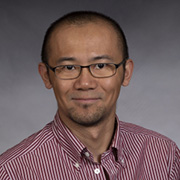A .gov website belongs to an official government organization in the United States.
A lock () or https:// means you've safely connected to the .gov website. Share sensitive information only on official, secure websites.

The ocean emits a variety of trace gases and aerosols, including volatile organic compounds and nitrogen-containing compounds, affecting tropospheric and stratospheric chemistry. Acetaldehyde (CH3CHO) has been widely measured in the atmosphere for decades. It's a fascinating compound for several reasons: Firstly, it's fairly simple and we know its primary sources and sinks reasonably well. Secondly, it's also unique, structurally, such that specific chemical mechanisms/pathways are needed to make an end aldehyde. Most importantly, despite decades of research, we now have more questions than answers. In the first half of this presentation, I will briefly review what we have learned about acetaldehyde, with an emphasis on its implications for the reactive carbon budget in the atmosphere.
In the second half of this presentation, I will focus on possible oceanic emissions of nitrogen oxides (NOx = NO + NO2). NOx play a key role in the atmosphere, modulating the ozone chemistry and affecting the self-cleaning capacity of the atmosphere. NOx observations in the remote marine boundary layer are frequently underestimated by global models, implying missing sources in the models. Interestingly, early studies back in the 1980s indicated that the surface ocean is often supersaturated with NO, and a small amount of NO emitted from the ocean is key to explain the ozone chemistry in the remote marine boundary layer. Inspired by these pioneering work, I developed a bottom-up oceanic NOx emission inventory which is then used in a global chemistry-climate model to explore its potential impacts on atmospheric chemistry. I will also explore the photolysis of particulate nitrate and discuss its role in NOx budget and oxidative capacity.
Dr. Siyuan Wang is a research scientist at CIRES, University of Colorado Boulder and at NOAA Chemical Sciences Laboratory in the Atmospheric Composition Modeling group. He earned his PhD in 2015 from the Hong Kong University of Science and Technology. His current research focuses on plume dynamics and chemical evolution of wildfire smoke, as well as the ocean biogeochemistry's control on atmospheric chemistry. He is also interested in the application and integration of novel machine learning techniques in Earth system models. He was an NCAR Advanced Study Program (ASP) postdoctoral fellow (2017-2019) and received a J. William Fulbright Junior Research Award in 2012-2013.
ALL Seminar attendees agree not to cite, quote, copy, or distribute material presented without the explicit written consent of the seminar presenter. Any opinions expressed in this seminar are those of the speaker alone and do not necessarily reflect the opinions of NOAA or CSL.